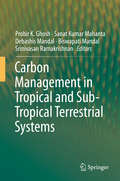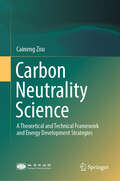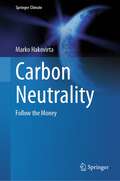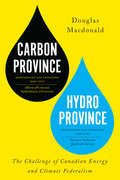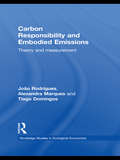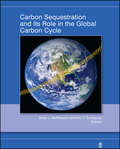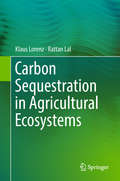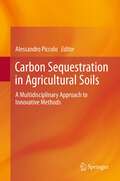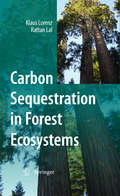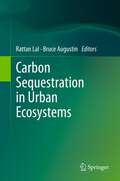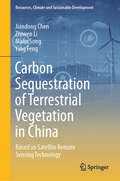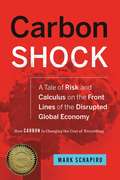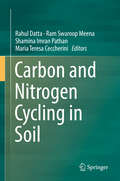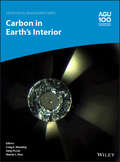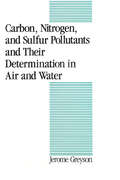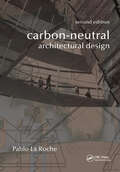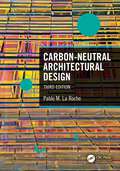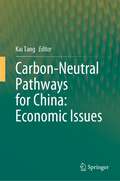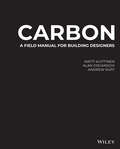- Table View
- List View
Carbon Management in Tropical and Sub-Tropical Terrestrial Systems
by Probir K. Ghosh Sanat Kumar Mahanta Debashis Mandal Biswapati Mandal Srinivasan RamakrishnanSoil organic carbon (SOC), a key component of the global carbon (C) pool, plays an important role in C cycling, regulating climate, water supplies and biodiversity, and therefore in providing the ecosystem services that are essential to human well-being. Most agricultural soils in temperate regions have now lost as much as 60% of their SOC, and as much as 75% in tropical regions, due to conversion from natural ecosystems to agricultural uses and mainly due to continuous soil degradation. Sequestering C can help to offset C emissions from fossil fuel combustion and other C-emitting activities, while also enhancing soil quality and long-term agronomic productivity. However, developing effective policies for creating terrestrial C sinks is a serious challenge in tropical and subtropical soils, due to the high average annual temperatures in these regions. It can be accomplished by implementing improved land management practices that add substantial amounts of biomass to soil, cause minimal soil disturbance, conserve soil and water, improve soil structure, and enhance soil fauna activity. Continuous no-till crop production is arguably the best example. These soils need technically sound and economically feasible strategies to sustainably enhance their SOC pools. Hence, this book provides comprehensive information on SOC and its management in different land-use systems, with a focus on preserving soils and their ecosystem services. The only book of its kind, it offers a valuable asset for students, researchers, policymakers and other stakeholders involved in the sustainable development and management of natural resources at the global level.
Carbon Markets or Climate Finance: Low Carbon and Adaptation Investment Choices for the Developing World (Routledge Explorations In Environmental Economics Ser. #34)
by Axel MichaelowaThis book builds on a decade-long experience with mechanisms provided by the Kyoto Protocol and the UN Framework Convention on Climate Change. It discusses the challenges of climate finance in the context of the post-Copenhagen negotiations and provides a long-term outlook of how climate finance in developing countries could develop. Written by climate finance experts from academia, carbon finance businesses and international organisations, the book provides background, firsthand insights, case studies and analysis into the complex subject area of climate finance.
Carbon Membrane Technology: Fundamentals and Applications
by Xuezhong He Izumi KumakiriCarbon membranes have great advantages of strong mechanical strength and high chemical stabilities, as well as high separation performance to reach the industrial attractive region. Further improvement on membrane performance can potentially offset the relatively high production cost compared to polymeric membranes. However, there are still some challenges related to fabrication of asymmetric carbon membranes, the controlling of structure and pore-size and module up-scaling for commercial application. The aim of this book is to provide the fundamentals on carbon membrane materials for the young researchers and engineers to develop frontier membrane materials for energy efficient separation process. This book describes the status and perspectives of both self-supported and supported carbon membranes from fundamentals to applications. The key steps on the development of high performance carbon membranes including precursor selection, tuning carbon membrane structure and regeneration are discussed. In the end, different potential applications both in gas and liquids separation are well described, and the future directions for carbon membrane development were pointed out. To this end, membrane science and engineering are set to play crucial roles as enabling technologies to provide energy efficient and cost-effective future solutions for energy and environment related processes. Based on this approach the research projects which are trying to find attractive carbon materials in our days are many. The published papers, per year, in the topic of carbon membranes, especially for biogas upgrading, natural gas sweetening and hydrogen purification, are numerous with very high impact. However, only few are the books which include relevant to the topic of carbon membrane technology. This book offers the condensed and interdisciplinary knowledge on carbon membranes, and provides the opportunity to the scientists who are working in the field of carbon membrane technology for gas and liquid separations to present, share, and discuss their contributions within the membrane community.
Carbon Neutrality Science: A Theoretical and Technical Framework and Energy Development Strategies
by Caineng ZouThis book focuses on the connotation and extension of carbon neutrality. It presents a full collection of various topics in carbon neutrality, including carbon production, reduction, utilization, storage, capture, markets, and society, etc. It concludes that carbon neutrality is the pathway to global green and low-carbon sustainable development and the foundation for building harmonious ecological civilization. This book is a valuable reference for researchers, practitioners, and policy-makers in the field of earth and environmental sciences.
Carbon Neutrality: Follow the Money (Springer Climate)
by Marko HakovirtaThis book offers a fresh, comprehensive outlook on a paramount global challenge: climate change, seamlessly integrating intricate themes like climate science, innovative technology solutions, strategic business models, essential investments, and societal impacts. The book targets decision-makers, business leaders, educators, and those seeking a comprehensive grasp of this critical issue. It imparts insights into the necessary strategic alignment to understand and address the diverse elements required for mitigating and adapting to climate change effects. As a practical guide, it delineates a clear roadmap for implementing solutions and driving essential transformations. By fusing these multifaceted aspects, the book constructs a comprehensive framework that offers astute guidance for navigating the path towards achieving global carbon neutrality and effectively combatting climate change.
Carbon Province, Hydro Province: The Challenge of Canadian Energy and Climate Federalism (G - Reference,information And Interdisciplinary Subjects Ser.)
by Douglas MacdonaldWhy has Canada been unable to achieve any of its climate-change targets? Part of the reason is that emissions in two provinces, Alberta and Saskatchewan, already about half the Canadian total when taken together, have been steadily increasing as a result of expanding oil and gas production. Declining emissions in other provinces, such as Ontario, Quebec, Nova Scotia and New Brunswick, have been cancelled out by those western increases. The ultimate explanation for Canadian failure lies in the differing energy interests of the western and eastern provinces, overlaid on the confederation fault-line of western alienation. Climate, energy, and national unity form a toxic mix. How can Ottawa possibly get all the provinces moving in the same direction of decreasing emissions? To answer this question, Douglas Macdonald explores the five attempts to date to put in place co-ordinated national policy in the fields of energy and climate change – from Pierre Trudeau’s ill-fated National Energy Program to Justin Trudeau’s bitterly contested Pan-Canadian program – analyzing and comparing them for the first time. Important new insights emerge from this analysis which, in turn, provide the basis for a new approach. Carbon Province, Hydro Province is a major contribution to both academic understanding and the vital question of how our federal and provincial governments can effectively work together and thereby for the first time achieve a Canadian climate-change target.
Carbon Responsibility and Embodied Emissions: Theory and Measurement (Routledge Studies In Ecological Economics Ser.)
by João F. Rodrigues Tiago M. Domingos Alexandra P.S. MarquesClimate change policy and the reduction of greenhouse gas emissions are currently discussed at all scales, ranging from the Kyoto Protocol to the increasingly frequent advertisement of ''carbon neutrality'' in consumer products. However, the only policy option usually considered is the reduction of direct emissions. Another potential policy tool, currently neglected, is the reduction of indirect emissions, i.e., the emissions embodied in goods and services, or the payments thereof. This book addresses the accounting of indirect carbon emissions (as embodied in international trade) within the framework of input-output analysis and derives an indicator of environmental responsibility as the average of consumer and producer responsibility. A global multi-regional input-output model is built, using databases on international trade and greenhouse gas emissions, from which embodied carbon emissions and carbon responsibilities are obtained. Carbon Responsibility and Embodied Emissions consists of a theoretical part, concerning the choice of environmental indicators, and an applied part, reporting an environmental multi-regional input-output model. It will be of particular interest to postgraduate students and researchers in Ecological Economics, Environmental Input-Output Analysis, and Industrial Ecology.
Carbon Risk and Green Finance (Banking, Money and International Finance)
by Aaron EzrojAs the world plans for economic recovery following the global COVID-19 pandemic, major economies are looking to comprehensive strategies for addressing carbon risks and identifying green finance opportunities. Since Bank of England Governor Mark Carney and Michael Bloomberg began tackling climate change as a financial concern, the international financial community has been developing sophisticated analytical tools that will enable the success of comprehensive efforts to address carbon risks and identify green finance opportunities. This timely publication offers a cutting-edge analysis of the financial aspects of climate change. It discusses the most important analytical tools, their origin, how they work, where they can go, and how they fit into a larger strategy. First, reporting frameworks can allow companies to see how well they are addressing carbon risks, in particular with respect to the recommendations of the Task Force on Climate-related Financial Disclosures. Second, by quantifying how much greenhouse gas companies emit into the atmosphere as a direct or indirect result of their operations, carbon footprint calculations can help identify carbon risks with particular companies, especially within supply chains. Third, brown taxonomies can help investors identify current carbon risks by classifying fossil fuel assets in a systematic manner. Fourth, green taxonomies can help investors identify current green finance opportunities by classifying sustainable activities in a systematic manner. Fifth, scenario analysis for assets can help investors identify future carbon risks and green finance opportunities. Finally, stress testing for liabilities can help insurers and banks address future carbon risks and better inform policymakers. Scholars, policymakers, and business professionals will find this book informative. They will gain a comprehensive understanding of the analytical tools supporting efforts to address carbon risks and identify green finance opportunities. This will hopefully make these individuals more successful in their personal endeavors to build a more sustainable and resilient economy for future generations.
Carbon Sequestration and Its Role in the Global Carbon Cycle
by Brian J. Mcpherson Eric T. SundquistPublished by the American Geophysical Union as part of the Geophysical Monograph Series, Volume 183.For carbon sequestration the issues of monitoring, risk assessment, and verification of carbon content and storage efficacy are perhaps the most uncertain. Yet these issues are also the most critical challenges facing the broader context of carbon sequestration as a means for addressing climate change. In response to these challenges, Carbon Sequestration and Its Role in the Global Carbon Cycle presents current perspectives and research that combine five major areas:The global carbon cycle and verification and assessment of global carbon sources and sinksPotential capacity and temporal/spatial scales of terrestrial, oceanic, and geologic carbon storageAssessing risks and benefits associated with terrestrial, oceanic, and geologic carbon storagePredicting, monitoring, and verifying effectiveness of different forms of carbon storageSuggested new CO2 sequestration research and management paradigms for the future.The volume is based on a Chapman Conference and will appeal to the rapidly growing group of scientists and engineers examining methods for deliberate carbon sequestration through storage in plants, soils, the oceans, and geological repositories.
Carbon Sequestration for Climate Change Mitigation and Adaptation
by Rattan Lal David A. UssiriThis book provides an understanding of the role of human activities in accelerating change in global carbon cycling summarizes current knowledge of the contemporary carbon budget. Starting from the geological history, this volume follows a multidisciplinary approach to analyze the role of human activities in perturbing carbon cycling by quantifying changes in different reservoirs and fluxes of carbon with emphasis on the anthropogenic activities, especially after the industrial revolution. It covers the role of different mitigation options – natural ecological, engineered, and geoengineered processes as well as the emerging field of climate engineering in avoiding dangerous abrupt climate change. Although the targeted audience is the educators, students, researchers and scientific community, the simplified analysis and synthesis of current and up to date scientific literature makes the volume easier to understand and a tool policy makers can use to make an informed policy decisions.
Carbon Sequestration in Agricultural Ecosystems
by Klaus Lorenz Rattan LalA comprehensive book on basic processes of soil C dynamics and the underlying factors and causes which determine the technical and economic potential of soil C sequestration. The book provides information on the dynamics of both inorganic (lithogenic and pedogenic carbonates) and organic C (labile, intermediate and passive). It describes different types of agroecosystems, and lists questions at the end of each chapter to stimulate thinking and promote academic dialogue. Each chapter has a bibliography containing up-to-date references on the current research, and provides the state-of-the-knowledge while also identifying the knowledge gaps for future research. The critical need for restoring C stocks in world soils is discussed in terms of provisioning of essential ecosystem services (food security, carbon sequestration, water quality and renewability, and biodiversity). It is of interest to students, scientists, and policy makers.
Carbon Sequestration in Agricultural Soils: A Multidisciplinary Approach to Innovative Methods
by Alessandro PiccoloThis compilation of techniques, methodologies and scientific data arises from a four-year Italian research project, which took place at university research stations in Turin, Piacenza, Naples and Potenza. Soil Organic Matter (SOM) represents an active and essential pool of the total organic carbon on the planet. Consequently, even small changes in this SOM carbon pool may have a significant impact on the concentration of atmospheric CO2. Recent new understanding of the chemical nature of SOM indicates that innovative and sustainable technologies may be applied to sequester carbon in agricultural soils. Overall results of the project have been applied to develop an innovative model for the prediction and description, both quantitatively and qualitatively, of carbon sequestration in agricultural soils. This book provides experts in different areas of soil science with a complete picture of the effects of new soil management methods and their potentials for practical application in farm management.
Carbon Sequestration in Forest Ecosystems
by Klaus Lorenz Rattan LalCarbon Sequestration in Forest Ecosystems is a comprehensive book describing the basic processes of carbon dynamics in forest ecosystems, their contribution to carbon sequestration and implications for mitigating abrupt climate change. This book provides the information on processes, factors and causes influencing carbon sequestration in forest ecosystems. Drawing upon most up-to-date references, this book summarizes the current understanding of carbon sequestration processes in forest ecosystems while identifying knowledge gaps for future research, Thus, this book is a valuable knowledge source for students, scientists, forest managers and policy makers.
Carbon Sequestration in Urban Ecosystems
by Rattan Lal Bruce AugustinUrbanization drastically alters the ecosystems structure and functions, disrupts cycling of C and other elements along with water. It alters the energy balance and influences climate at local, regional and global scales. In 2008, urban population exceeded the rural population. In 2050, 70% of the world population will live in urban centers. The number of megacities (10 million inhabitants) increased from three in 1975 to 19 in 2007, and is projected to be 27 in 2025. Rapid urbanization is altering the ecosystem C budget. Yet, urban ecosystems have a large C sink capacity in soils and biota. Judicious planning and effective management can enhance C pool in urban ecosystems, and off-set some of the anthropogenic emissions. Principal components with regards to C sequestration include home lawns and turfs, urban forests, green roofs, park and recreational/sports facilities and urban agriculture.
Carbon Sequestration of Terrestrial Vegetation in China: Based on Satellite Remote Sensing Technology (Resources, Climate and Sustainable Development)
by Malin Song Jiandong Chen Zhiwen Li Ying FengThis book estimates terrestrial vegetation carbon sequestration data based on remote sensing satellite data, collects the temporal and spatial characteristics of carbon sequestration by vegetation at county level and grid scale in China, and predicts the future change of carbon sequestration by vegetation in China. Based on the major strategic development goals and specific practices of China's carbon neutrality, this book shifts the research perspective from the side of carbon reduction to the weaker side of carbon sequestration. It not only broadens and enriches the research boundaries and theoretical connotation in the field of carbon neutrality, but also provides a perspective reference for further research on carbon sequestration by vegetation, which has pioneering academic value for future research on carbon dioxide. The satellite data is collected to calculate China's long time series and multi-type district and county vegetation carbon sequestration data set, which can meet different research needs and application scenarios. The practical value lies in providing basic data for the research of carbon neutrality, the establishment of carbon trading market and the calculation of vegetation carbon sink, and providing an important reference index for evaluating the ecological and environmental effects of land change. This book combines remote sensing technology, Geographic Information Science (GIS), spatial visualization technology and index decomposition technology to measure vegetation carbon sequestration in counties and districts of China, reveals the spatial-temporal dynamic change process of vegetation carbon sequestration, and explores the driving influence of social factors.
Carbon Shock
by Mark SchapiroAs the world moves toward making more and more polluters pay to emit carbon, a financial mystery unfolds: What are the costs? Who has the responsibility to pay for them? Who do you pay? How do you pay? And what are the potential impacts? These are the questions veteran journalist Mark Schapiro attempts to answer as he illuminates the struggle to pinpoint carbon’s true costs and allocate them fairly—all while bumping up against the vagaries of the free market, the lobbying power of corporations, the political maneuverings of countries, and the tolerance of everyday consumers buying a cup of coffee, a tank of gas, or an airplane ticket. Along the way, Schapiro tracks the cost of carbon through the drought-ridden farmland of California, where higher temperatures are driving up the price of the food we eat, the prices farmers pay for crop insurance, and the impact on taxpayers. Through the jungles of Brazil, where foreign polluters pay to keep trees standing—as offsets to absorb CO2—at a fraction of the cost they are worth to the struggling communities around them, who engage in logging or other uses. Through the world's greatest manufacturing center, asking who should pay for the pollution generated there—the Chinese who operate the factories or the Westerners who consume the goods they produce? Through the skies, where recent efforts to put a price tag on the carbon left by airplanes in the no-man's land of the atmosphere created what amounted to a quiet but powerful global trade war. Through the carbon-trading capital of Europe, where economists try to establish a price for a bizarre new commodity—a ton of carbon that will not be emitted—literally selling the air in an effort to curtail emissions. And, finally, through the high-tech crime world the new carbon markets have inspired, and the emerging nations that—as they amp up manufacturing, put more cars on their streets, and up their consumption—teeter on the brink of this wild, new carbon economy. For almost two decades, the primary topic of global climate negotiations has been to find a way to pay for the costs of carbon, slow greenhouse gas emissions, and stimulate a shift away from fossil fuels in order to shrink the earth’s carbon footprint. The key tool to date—the international carbon trade—has foundered in a sea of questions deftly explored by Schapiro, and in the turmoil of a global recession. As we approach the next climate negotiations in 2015, will nations stick to business as usual? Or will the world come to terms with the real price for carbon, and figure out a sensible way to pay for it?
Carbon Taxes: Their Macroeconomic Effects and Prospects for Global Adoption--A Survey of the Literature
by Ved P. Gandhi Javier CuervoA report from the International Monetary Fund.
Carbon and Nitrogen Cycling in Soil
by Ram Swaroop Meena Rahul Datta Shamina Imran Pathan Maria Teresa CeccheriniSeveral textbooks and edited volumes are currently available on general soil fertility but‚ to date‚ none have been dedicated to the study of “Sustainable Carbon and Nitrogen Cycling in Soil.” Yet this aspect is extremely important, considering the fact that the soil, as the ‘epidermis of the Earth’ (geodermis)‚ is a major component of the terrestrial biosphere. This book addresses virtually every aspect of C and N cycling, including: general concepts on the diversity of microorganisms and management practices for soil, the function of soil’s structure-function-ecosystem, the evolving role of C and N, cutting-edge methods used in soil microbial ecological studies, rhizosphere microflora, the role of organic matter (OM) in agricultural productivity, C and N transformation in soil, biological nitrogen fixation (BNF) and its genetics, plant-growth-promoting rhizobacteria (PGPRs), PGPRs and their role in sustainable agriculture, organic agriculture, etc. The book’s main objectives are: (1) to explain in detail the role of C and N cycling in sustaining agricultural productivity and its importance to sustainable soil management; (2) to show readers how to restore soil health with C and N; and (3) to help them understand the matching of C and N cycling rules from a climatic perspective.Given its scope, the book offers a valuable resource for educators, researchers, and policymakers, as well as undergraduate and graduate students of soil science, soil microbiology, agronomy, ecology, and the environmental sciences. Gathering cutting-edge contributions from internationally respected researchers, it offers authoritative content on a broad range of topics, which is supplemented by a wealth of data, tables, figures, and photographs. Moreover, it provides a roadmap for sustainable approaches to food and nutritional security, and to soil sustainability in agricultural systems, based on C and N cycling in soil systems.
Carbon in Earth's Interior (Geophysical Monograph Series #250)
by Jung-Fu Lin Craig E. Manning Wendy L. MaoExplores the behavior of carbon in minerals, melts, and fluids under extreme conditions Carbon trapped in diamonds and carbonate-bearing rocks in subduction zones are examples of the continuing exchange of substantial carbon between Earth’s surface and its interior. However, there is still much to learn about the forms, transformations, and movements of carbon deep inside the Earth. Carbon in Earth's Interior presents recent research on the physical and chemical behavior of carbon-bearing materials and serves as a reference point for future carbon science research. Volume highlights include: Data from mineral physics, petrology, geochemistry, geophysics, and geodynamics Research on the deep carbon cycle and carbon in magmas or fluids Dynamics, structure, stability, and reactivity of carbon-based natural materials Properties of allied substances that carry carbon Rates of chemical and physical transformations of carbon The American Geophysical Union promotes discovery in Earth and space science for the benefit of humanity. Its publications disseminate scientific knowledge and provide resources for researchers, students, and professionals.
Carbon, Nitrogen, and Sulfur Pollutants and Their Determination in Air and Water
by Jerome C. GreysonFor chemists and engineers in ecology, food science, pollution control, and related fields. Details the procedures available for monitoring and controlling carbon, sulfur, and nitrogen pollutants in such industries as waste water treatment, energy, transportation, pharmaceuticals, and mining. Outlin
Carbon-Neutral Architectural Design
by Pablo M. La RocheThe energy used to operate buildings is one of the most significant sources of greenhouse gas emissions. While it is possible to reduce emissions through climate-responsive design, many architects are not trained to do this. Filling an urgent need for a design reference in this emerging field, this book describes how to reduce building-related greenhouse gas emissions through appropriate design techniques. It presents strategies to achieve CO2 reductions, with an emphasis on control of energy flows through the building envelope and passive heating and cooling strategies. This new, revised edition is updated throughout, and includes a new chapter on building simulations.
Carbon-Neutral Architectural Design
by Pablo M. La RocheThe energy used to build and operate buildings is a significant source of greenhouse gas emissions. While it is possible to reduce emissions through low-carbon design, many architects are not trained to do this. Filling an urgent need for a design reference in this emerging field, this book describes how to reduce building-related greenhouse gas emissions through appropriate design techniques. It presents strategies to achieve CO2 reductions, with an emphasis on control of energy flows through the building envelope and passive cooling and heating strategies. This new, revised edition is updated throughout and includes a new section on embodied carbon and new chapters on daylighting and nature-based cooling.Features: Adds new chapters on daylighting and nature-based cooling with numerous updates throughout the rest of the chapters Presents strategies, illustrated with examples, for new construction and existing buildings to reduce energy consumption and reduce emissions Explains the origins of CO2 emissions associated with the operation and fabrication of buildings: supplying water, disposing of waste from the building, and proposes strategies to reduce them Covers carbon calculations, thermal comfort, indigenous technology, climate‑responsive design, passive cooling and heating, solar design, air flow analysis, daylighting, building simulation and microclimate design with abundant examples Examines siting/location to design buildings that adapt and mitigate their effect on climate change
Carbon-Neutral Pathways for China: Economic Issues
by Kai TangThis book provides comprehensive economic analyses on the paths to net-zero for China. It gives a detailed overview of issues and challenges related to carbon neutrality of the global largest emitter which have not been adequately addressed e.g., reduction costs and efficiency of existing actions, the multiple impacts of the newly established carbon market, and the potentials and costs of nature-based solutions such as biophysical sequestration, etc. Studies on China’s carbon reduction have attracted scientists and policymakers from diverse backgrounds. Pursuing a holistic and systematic approach, the book establishes a fundamental framework for this topic, emphasizing the importance of integrated technical-economic-policy analysis. This book will not only be an essential reference to the carbon-neutral progress in China but also will be an outstanding text book on carbon-neutral management. Similarly, this book is expected to attract a great range of readership including undergraduate and postgraduate students, economic and climate specialists, researchers and policymakers in China as well as in overseas.
Carbon-based Nanomaterials for Green Applications
by Upendra Kumar Suman Lata Tripathi Piyush Kumar SonkarGain valuable insight into applying carbon-based nanomaterials to the green technologies of the future The green revolution is the most important technological development of the new century. Carbon-based nanomaterials, with their organic origins and immense range of applications, are increasingly central to this revolution as it unfolds. There is an urgent need for an up-to-date overview of the latest research in this ever-expanding field. Carbon-Based Nanomaterials for Green Applications meets this need by providing a brief outline of the synthesis and characterization of different carbon-based nanomaterials, including their historical backgrounds. It proceeds to move through each major category, outlining properties and applications for each. The result is an essential contribution to a huge range of sustainable and renewable industries. With contributions from a global list of distinguished writers, the book includes: Discussion of nanomaterial applications in fields from drug delivery to biomedical technology to optics Analysis of nanomaterial categories including graphene, fullerene, mesoporous carbon, and many more Separate chapters describing aspects of supercapacitors, solar cells, and fuel cells Carbon-Based Nanomaterials for Green Applications is ideal for scientists and researchers working in nanotechnology, life sciences, biomedical research, bioengineering, and a range of related fields.
Carbon: A Field Manual for Building Designers
by Matti Kuittinen Alan Organschi Andrew RuffA comprehensive approach to design that integrates sustainable principles and design strategies for decarbonized construction Representing an international collaboration between academics and architects in the United States and Europe, Carbon: A Field Manual for Designers and Builders offers professionals in the field an approach to sustainable design that embraces building science principles, life-cycle analysis, and design strategies in carbon neutral construction. The book also contains background information on carbon in construction materials and in the building design process. This book is filled with illustrative diagrams and drawings that help evaluate the potential impact of design decisions for creating carbon emissions. Written by and for designers and builders, the book includes a compelling pair of case studies that explore carbon-reducing strategies, suggests steps for assessing a building's carbon footprint, and reviews carbon storages and circulation of materials. The guidelines detailed in the book can be adopted, replicated, and deployed to reduce carbon emissions and create more sustainable buildings. This important book: Offers an effective approach to sustainable design in construction Integrates building science principles, life-cycle analysis, and design strategies in carbon neutral construction Describes a methodology for quantifying the flow of carbon in the built environment Provides an analysis of carbon-reducing strategies based on a case study of a building designed by the authors Written for practicing professionals in architecture and construction, Carbon: A Field Guide for Designers and Builders is a must-have resource for professionals who are dedicated to creating sustainable projects.
